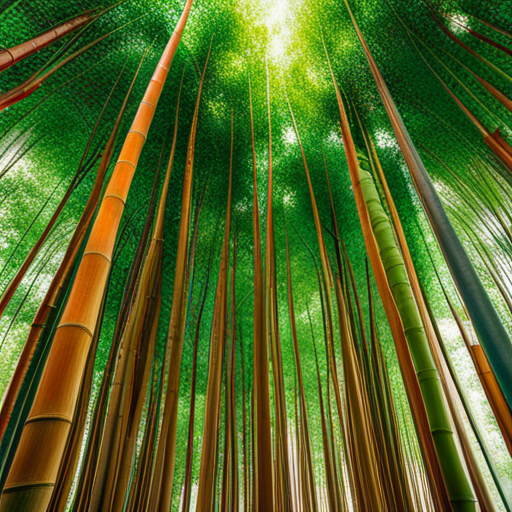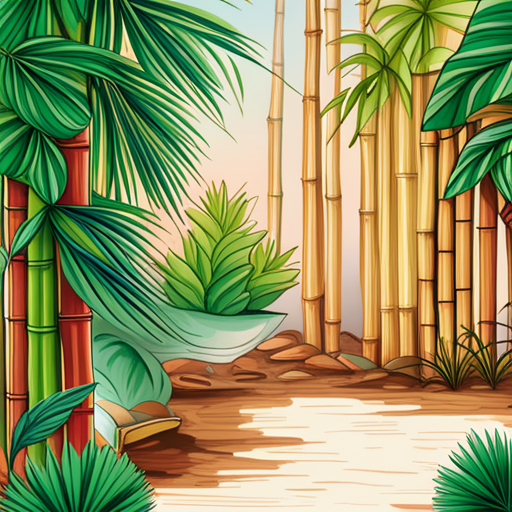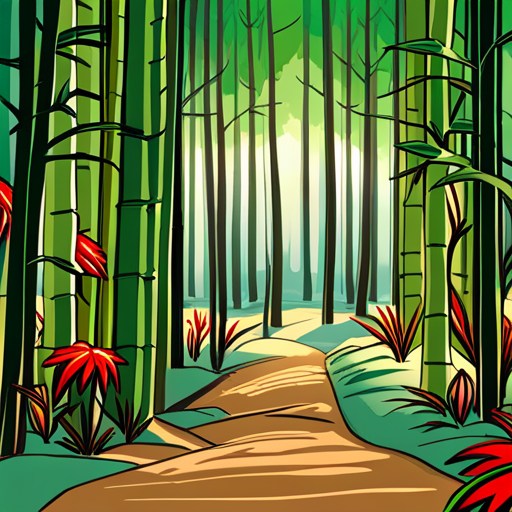However, specific bamboo species may exhibit semi-deciduous behavior, losing foliage temporarily during cold winters or severe droughts. Selecting a bamboo variety that is well adapted and hardy in a particular climate is crucial for successful growth. Growing bamboo outside its climate necessitates extra care and may result in slower growth or smaller size.
This article explores the characteristics of bamboo, including its growth patterns and leaf shedding, and provides guidance on caring for these plants. By understanding the unique qualities of bamboo and ensuring appropriate cultivation practices, individuals can enjoy the perennial allure of these evergreen plants in their gardens and landscapes.
Contents
- 1 Our Highlighted Points
- 2 Bamboo’s Characteristics
- 3 Growth and Leaf Shedding
- 4 Caring for Bamboo
- 5 Do Bamboo Plants Flower?
- 6 Frequently Asked Questions
- 6.1 Can bamboo be grown indoors as a houseplant?
- 6.2 How fast does bamboo grow and how tall can it get?
- 6.3 What are the different types of bamboo and their characteristics?
- 6.4 Is bamboo a good choice for erosion control in gardens?
- 6.5 Are there any potential health hazards associated with growing bamboo?
Our Highlighted Points
- Bamboo is known for its vibrant green color and evergreen foliage.
- Selecting a well-adapted and hardy bamboo variety is crucial for successful growth.
- Bamboo can thrive in both tropical and temperate climates, and its ability to withstand snow and cold temperatures enhances its appeal as an evergreen plant.
Bamboo’s Characteristics

Bamboos are known to be evergreen plants, maintaining their vibrant green color throughout the year, except in certain climates or situations where they may shed some leaves during winter or drought.
One of the remarkable characteristics of bamboo is its adaptability to various environments. It can thrive in both tropical and temperate climates, making it a popular choice for landscaping purposes. Bamboo’s ability to withstand snow and cold temperatures further enhances its appeal as an evergreen plant.
Its lush green foliage provides a year-round beauty and adds a touch of elegance to any garden or outdoor space. Additionally, bamboo’s fast growth rate and dense growth habit make it an excellent option for creating privacy screens or hedges. Its versatility and aesthetic qualities make bamboo a valuable asset in landscaping design.
Growth and Leaf Shedding

In their native environments, bamboos exhibit continuous shedding of leaves throughout the year, with the amount being relatively insignificant. Leaf shedding patterns in bamboo are influenced by various factors.
Firstly, as temperatures rise, bamboo starts growing new shoots and leaves, resulting in increased leaf shedding. This new growth and falling leaves happen almost simultaneously.
Additionally, certain bamboo species behave as semi-deciduous plants in some climates, shedding more leaves during winter or drought. However, not all bamboo will lose their leaves in cold and snowy winters.
Factors such as cold winter or severe drought can cause bamboo to temporarily lose foliage. It is important to choose a bamboo plant that is well adapted and hardy in your climate to ensure successful growth.
By considering these factors, you can maintain the year-round beauty of bamboo in your garden.
Caring for Bamboo

When caring for bamboo, it is crucial to choose a well-adapted and hardy species that is suitable for your climate. Growing tips include selecting a location with adequate sunlight, as most bamboos thrive in full sun or partial shade. Additionally, ensuring proper soil drainage is essential, as bamboo does not tolerate waterlogged conditions.
Regular watering is necessary, especially during dry periods, to maintain soil moisture. Pruning techniques can help control the size and shape of bamboo. Removing old or damaged canes can promote new growth and maintain a tidy appearance. It is recommended to prune in late winter or early spring before the new shoots emerge.
However, it’s important to note that pruning should be done sparingly, as excessive pruning can weaken the plant and reduce its vigor. By following these tips and techniques, you can successfully care for bamboo and enjoy its year-round beauty.
Do Bamboo Plants Flower?
Bamboo plants are known for their fascinating bamboo reproduction and flowering process. Although it’s rare, bamboo plants do flower. This phenomenon, known as flowering, occurs once in several decades or even centuries, depending on the species. When it happens, bamboo flowers can create a stunning display of colors, attracting curious onlookers.
Frequently Asked Questions
Can bamboo be grown indoors as a houseplant?
Bamboo can be grown indoors as a houseplant, offering various benefits for indoor decoration. To successfully grow bamboo indoors, provide it with adequate light, water, and humidity. Use well-draining soil and avoid overwatering. Regularly prune to maintain its desired size and shape.
How fast does bamboo grow and how tall can it get?
The growth rate of bamboo can vary depending on the species and environmental factors, but on average, bamboo can grow between 1 to 4 feet per day. Some species can reach a maximum height of over 100 feet.
What are the different types of bamboo and their characteristics?
There are various types of bamboo with distinct characteristics. These include clumping bamboo, running bamboo, and timber bamboo. Clumping bamboo forms tight clumps, running bamboo spreads aggressively, and timber bamboo is known for its large size and strength.
Is bamboo a good choice for erosion control in gardens?
Bamboo is a suitable choice for erosion control in gardens due to its extensive root system, which helps stabilize soil. It also forms a dense barrier, preventing soil erosion. Additionally, bamboo can enhance the aesthetic value of the landscape.
Are there any potential health hazards associated with growing bamboo?
Potential health hazards associated with growing bamboo include skin irritation from contact with the plant’s sharp edges or sap, allergies to bamboo pollen, and respiratory issues due to inhaling bamboo dust. Additionally, bamboo’s invasive nature can have negative environmental impacts if not properly managed.

